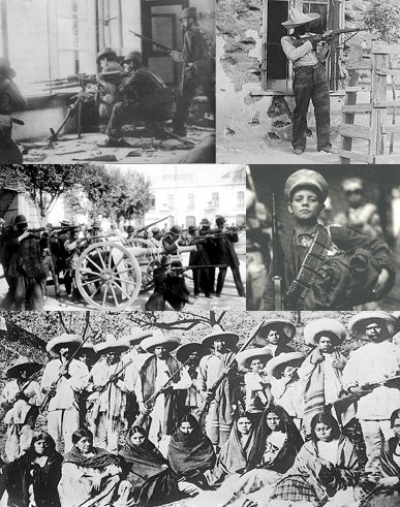The Plan of San Luis de Potos (Spanish: Plan de San Luis) is a key political document of the Mexican Revolution, written by Mexican presidential candidate Francisco I. Madero, following his escape from jail. He had challenged President Porfirio Daz in the 1910 presidential elections, when Daz was 80 years old, and garnered a broadbased following. Daz jailed him when it became clear Madero might win. Madero escaped and drafted the plan to explain why armed rebellion against Daz was now the only way to remove him from office. It was published on October 5, 1910. It called for nullifying the fraudulent 1910 election of Porfirio Daz, proclaimed Madero as provisional president, and called for Mexicans to revolt on November 20, 1910.
The Mexican Revolution (Spanish: Revolución Mexicana) was an extended sequence of armed regional conflicts in Mexico from 1910 to 1920. It has been called "the defining event of modern Mexican history." It resulted in the destruction of the Federal Army and its replacement with a revolutionary army, transformed Mexican culture and government. The northern Constitutionalist faction prevailed on the battlefield and drafted the present-day Constitution of Mexico, which aimed to create a strong central government, with revolutionary generals holding power from 1920 to 1940. The revolutionary conflict was primarily a civil war, but foreign powers, having important economic and strategic interests in Mexico, figured in the outcome of Mexico's power struggles. The United States played an especially significant role.Although the decades-long regime of President Porfirio Díaz (1876–1911) was increasingly unpopular, there was no foreboding that a revolution was about to break out in 1910. The aging Díaz failed to find a controlled solution to presidential succession, resulting in a power struggle among competing elites and the middle classes, which occurred during a period of intense labor unrest, exemplified by the Cananea and Río Blanco strikes. When wealthy northern landowner Francisco I. Madero challenged Díaz in the 1910 presidential election and Díaz jailed him, Madero called for an armed uprising against Díaz in the Plan of San Luis Potosí. Rebellions broke out in Morelos, but most prominently in northern Mexico. The Federal Army was unable to suppress the widespread uprisings, showing the military's weakness and encouraging the rebels. Díaz resigned in May 1911 and went into exile, an interim government installed until elections could be held, the Federal Army was retained, and revolutionary forces demobilized. The first phase of the Revolution was relatively bloodless and short-lived.
Madero was elected President, taking office in November 1911. He immediately faced the armed rebellion of Emiliano Zapata in Morelos, where peasants demanded rapid action on agrarian reform. Politically inexperienced, Madero's government was fragile, and further regional rebellions broke out. In February 1913, prominent army generals from the Diaz regime staged a coup d'etat in Mexico City, forcing Madero and Vice President Pino Suárez to resign, and few days later both were murdered by orders of new President, Victoriano Huerta. A new and bloody phase of the Revolution ensued when coalition of northerners opposed to the counter-revolutionary regime of Huerta, the Constitutionalist Army. The Constitutionalists were led by Governor of Coahuila, Venustiano Carranza. Zapata's forces continued their armed rebellion in Morelos. Huerta's regime lasted from February 1913 to July 1914, with the Federal Army defeated by revolutionary armies. The revolutionary armies then fought each other, with the Constitutionalist faction under Carranza defeating the army of former ally Pancho Villa by the summer of 1915.
Carranza consolidated power and a new constitution was promulgated in February 1917. The Mexican Constitution of 1917 established universal male suffrage, promoted secularism, workers' rights, economic nationalism and land reform, and enhanced the power of the federal government. Carranza became President of Mexico in 1917, serving a term ending in 1920. He attempted to impose a civilian successor, prompting northern revolutionary generals to rebel. Carranza fled Mexico City and was killed. From 1920 to 1940, revolutionary generals held office, a period when State power became more centralized and revolutionary reforms implemented, bringing the military under control of the civilian government. The Revolution was a decade-long civil war, with a new political leadership that gained power and legitimacy through their participation in revolutionary conflicts. The political party they founded, which would become the Institutional Revolutionary Party, ruled Mexico until the presidential election of 2000, when an opposition party won. Even the conservative winner of that election, Vicente Fox, contended his election was heir to the 1910 democratic election of Francisco Madero, thereby claiming the heritage and legitimacy from the Revolution.

1910Nov, 20
Mexican Revolution: Francisco I. Madero issues the Plan de San Luis Potosí, denouncing Mexican President Porfirio Díaz, calling for a revolution to overthrow the government of Mexico, effectively starting the Mexican Revolution.
Choose Another Date
Events on 1910
- 11May
Glacier National Park (U.S.)
An act of the U.S. Congress establishes Glacier National Park in Montana. - 4Jul
Jack Johnson (boxer)
African-American boxer Jack Johnson knocks out white boxer Jim Jeffries in a heavyweight boxing match, sparking race riots across the United States. - 15Jul
Alzheimer's disease
In his book Clinical Psychiatry, Emil Kraepelin gives a name to Alzheimer's disease, naming it after his colleague Alois Alzheimer. - 18Sep
Suffrage
In Amsterdam, 25,000 demonstrate for general suffrage. - 7Nov
Wright brothers
The first air freight shipment (from Dayton, Ohio, to Columbus, Ohio) is undertaken by the Wright brothers and department store owner Max Moorehouse.

 English
English  español
español  français
français  português
português  русский
русский  العربية
العربية  简体中文
简体中文 